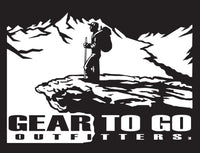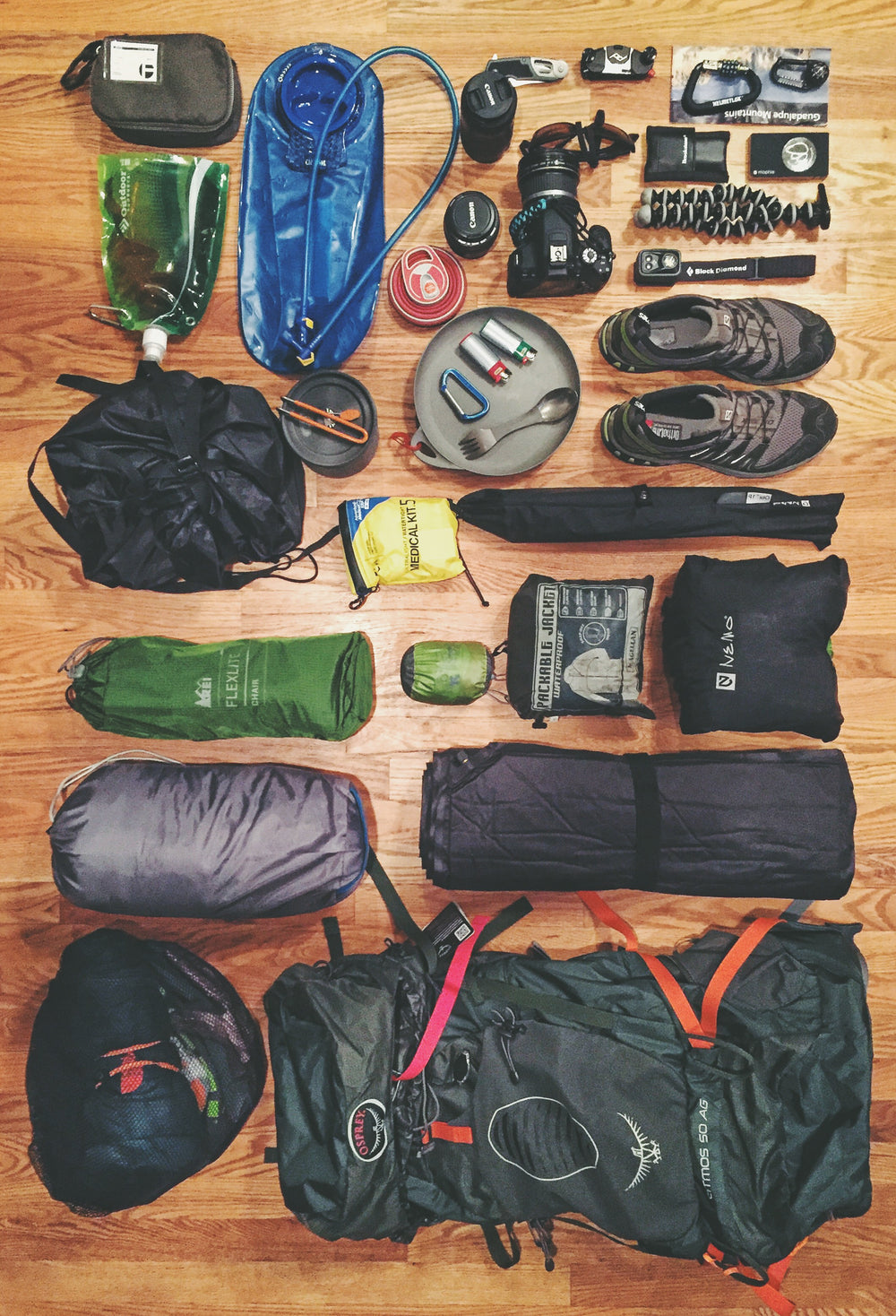Whether going out for a day-hike or 2-week backpacking trip, or just a weekend at a developed campground at a nearby state park, there are some essentials you should always have with you.
The basics of any overnight stay include 5 categories you need to cover in some form or another
Shelter - includes personal protective cover such as a tent, clothing and footwear
Sleeping gear - for most people, that's a sleeping bag and mattress pad
Nourishment - Food and water, and a means of filtering and cooking
Lighting - it's dark out there, so flashlight, headlamp, or lantern
Transportation - car, trailer, or a backpack
We rent a lot of what you'll need; see all of our rental gear as a good start.
After that, there's everyone's (different) version of the "10 essential items", especially if you'll be hiking away from camp or backpacking. Here’s our version, plus some second-tier suggestions to consider.
Map and compass, or clearly know where you’re headed.
It’s one thing to get lost with a map; it’s just stupid to get lost because you didn’t have a map in the first place. And now available are virtually idiot-proof GPS units. Take a map, compass and GPS if possible; a map if only one is available. There are now lots of communicate-back-home options as well in case of emergency - you may well be in cell phone range, or check out our SPOT Messenger device.
Carry enough water to last your entire trip or a way to treat water as you go.
Without enough water, your body just doesn’t work right. Go 3 days without food; you’ll lose some weight. Go 3 days without water, you’re toast. And taking in bad water is no bargain either, so be prepared; see our water filter rental options. For more tips and suggestions check out this page on wilderness water treatment.
Enough Food.
You can burn thousands of calories a day while backpacking, so carry enough food to at least keep you from getting weak. And have some extra in case of a detour, losing the trail, or an injury. Take a mix of carbs, protein and fat, and a variety of snacks to keep things interesting.
The right clothing.
The weatherman isn’t always right and whatever he’s saying rarely applies to higher altitudes anyway. Dress in layers of synthetic materials when possible. Avoid denim and cotton, unless you want to weigh 100 pounds heavier when wet. Carry at least a lightweight water-proof jacket if there’s any chance for rain. And most important - a good pair of shoes. More hikes end early due to blisters than for any other reason.
Lighter or waterproof matches.
Fires can save your life in cold weather and can help someone find you in case of emergency.
First aid kit/whistle/Advil.
Raid your own cabinet for supplies or you can buy a prepackaged first aid kit from us. Three blasts on a whistle will carry further and prompt help faster than any yelling will do. And when the mind is willing on Day 2, but the lactic acid in your legs won’t cooperate, try Advil or your favorite pain killer - works wonders.
Army knife or multi-purpose tool.
You can’t imagine how often you’ll use a good multi-tool on the trail - until you go out without one in your pack. Get a light one though.
Flashlight.
For finding your way in the dark and signaling for help. Renting a hands-free headlamp is best.
Sun/insect protection.
Otherwise you can fry your skin or hurt your eyes if you’re out all day in the sun, particularly at higher altitudes. Repellents can save you from the diseases that bugs carry and keep you from going crazy from the buzzing in your ears.
Attitude.
Remember why you’re headed out in the first place - to get away. The weight of your pack, the occasional blister, the rain - all temporary; soon forgotten. The memories of a good trip will last a lifetime.
And here’s 10 secondary things you should consider adding to your gear mix. You won’t die without them, but they can make a trip more enjoyable and comfortable.
Camera.
Lots of photo-worthy moments on the trail. Take a lightweight digital or phone so you can share photos with friends and family and prove you were there. Camera batteries outlast smartphones'.
Waterless handwash/Towelettes/alcohol.
Keep your hands clean, and you’ll be less likely to catch something nasty. Keep the rest of you clean, and you’ll feel better, sleep better, chafe less, and smell better to your partners. Trick - if no water is available for a mini-bath of sorts, take cotton balls; soak in alcohol from small dispenser, and use to clean your face, armpits and groin area.
Rope and Duct tape.
20' of small-diameter nylon rope doesn’t weigh much, but is handy for all kinds of things - hanging clothes, food away from critters, etc - and duct tape is useful for everything from blisters to tent repairs. Hint - don’t take a whole roll of tape; just unwrap a few feet and re-wrap around something you’re taking anyway, like your bug spray can or hiking pole.
Trekking poles.
Hiking poles are a great addition on any backpacking trip; well worth the cost. Help in balancing across creek crossings; taking pressure off knees going up and down hills; looks cool in photos! How to use?
Extra socks.
Nothing’s worse than squishy socks from creeks or sweat. Take 3 pair on long trips - one to start out the day with; one to swap out midday. Wash those two at night; start out with third pair next morning. Or alternate two pairs every other day and keep one pair clean for sleeping in. Hang others on pack to finish drying.
Fresh Fruit.
Heavy, yes, so take just enough to eat up first day out. But your body will appreciate the variety from freeze-dried food and energy bars you’ll have the rest of your trip. Dried fruit is just not the same.
Batteries.
If you’re taking electronic anything - flashlight or GPS, etc - take some extras.
Sandwich baggies/Trash bags.
Use to cover your pack or at least protect your sleeping bag if it starts raining. Also great to have to set your gear out on dewy mornings, and then later to carry your trash out. Sandwich bags are good to keep your small items together and to keep things that need to be dry, dry.
Gatorade/Tea/Coffee/sweets.
Gatorade or other electrolyte supplement is good on hot hikes as a continual light calorie source and helps keep muscles from cramping. Anything with caffeine is good in the morning to get you started for the day. And don’t worry about gaining weight on a backpacking trip - eat sweets fairly guilt-free, particularly while on the trail. The carb and sugar buzz will help you sustain energy, but too much sugar can get you nauseated - try to maintain a balance. If you're used to a low-carb diet, you can get away with mostly protein and fats instead, but on the trail is not a place to try a new diet.
Handwarmers.
Cool invention - just open and insert into your gloves on ice-cold days, or throw into your sleeping bag at night to add surprising warmth. We sell them here on this site.
As you can see, there are lots of choices to pack. It’s important to have enough with you to be prepared, but not take so much stuff that the weight of your pack becomes unmanageable. The shorter the trip, perhaps the more "luxuries" you can afford weight-wise to take with you. Your best insurance against packing too much is to weigh your loaded pack before heading out - weigh yourself with and without the pack; if your carrying weight is much more than 30 pounds for a weekend trip, start shedding. Some ultra-light fans would say anything over 20 pounds is too much, but there is usually some sacrifice in sleeping comfort or shelter the lighter you go.
If you’re a beginner and want some more suggestions, just enter "backpacking tips" into any search engine. You’ll see there’s lots of hikers out there willing to share ideas and experiences, or just give us a call at 866-994-4537 for additional advice.


Comments
0 comments